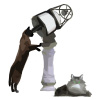
The Astrophysics Spectator
The western tradition of astronomy is now over three-thousand years old. Most people are well aware of the beginnings of modern astronomy, which began with Galileo, Copernicus, and Kepler in the 16th century. This modern tradition starts with a proper understanding of some basic physics—the concept of inertial, specifically that a body in motion stays in motion unless acted upon by a force—a breakthrough in the theory of the Solar System—Earth and the planets orbit the Sun on ellipses—and the use of optical instruments. From that time to this, astronomy has jumped from a science of the Solar System to a science that encompasses up to 1023 stars spread across a distance 1015 times the distance to Saturn. But initiating modern astronomy required 2500 years of effort by Western astronomers.
The Babylonians conducted the first systematic astronomy in the West. Their motives were religious, and their work was empirical. They created the symbols of the zodiac and invented astrology; the Babylonian astronomers studied the stars to to understand the fate of the Babylonian rulers. This community of astronomers left behind an observational record of planetary motion that begins around 1600 BC, continues through Alexander the Great's conquest of Asia Minor in 331 BC, and extends to the collapse of Macedonian rule over Babylon in 125 BC.
Greek astronomy begins in the fifth century BC. The Greeks adopted the Babylonian constellations and introduced geometry into their study of astronomy. The Greeks of the classical era developed the correct explanations for the phases of the moon, and they correctly interpreted as evidence that Earth is a sphere a number of observations, such as the curvature of Earth's shadow on the Moon during a lunar eclipse, and the disappearance of a ship over the horizon. By the era of Aristotle, the idea that the planets moved along circles was established. In the second century AD, in Alexandria, under the Macedonian dynasty established in Egypt following the death of Alexander, the astronomer Ptolemy developed a systematic geometric description of the motions of the planets around Earth, grounding this theory in his detailed observations of planetary motions. This work marked the high-point of Western astronomy until Copernicus developed his theory of the Solar System.
As ancient astronomy advanced, so did the astronomical instruments. The first instruments were simple sticks. A stick set vertically, so that it casts a shadow, is known as a gnomon; besides giving a measure of time during the day, the shadow can tell an observer the dates of the solstices and the equinoxes. A stick mounted as a sight-line, called a diopta, enables an astronomer to measure the positions of stars and planets. As the centuries passed, the instruments became more sophisticated. Globes of the stars came into use during the classical Greek era. Later eras saw the creation of the armillary sphere, which is a globe of earth inside of a framework to show the ecliptic and the tropics of Cancer and Capricorn. Eventually the most useful of the ancient instruments, the astrolabe, was invented and in use by the first century BC. This instrument is an analog calculator, similar to a slide rule, that shows the positions of the stars and the ecliptic above the local horizon. These instruments also had a sight for measuring the altitude of a star or planet above the horizon. This instrument remained in use through the era of Arab astronomy into the European Renaissance.
In his textbook The History and Practice of Ancient Astronomy, James Evans develops the history of astronomy from the Babylonians up through Arab astronomy to the astronomy of Copernicus and Kepler through the instruments and observations of the ancient astronomers. This is a nice change from most histories of astronomy, which concentrate on the ancient astronomical theories. The latter type of history gives the impression that ancient astronomers were simply not smart enough to recognize the correct theory; seeing the actual process of creating a new theory from the data available to the ancient astronomers corrects this misperception and underscores the difficulty of creating a valid theory.
A central theme of this is is the construction and use of the ancient instruments. Evens covers the construction of gnomon and sundials, but the most prominent discussion is of the astrolabe. The book includes templates for making an astrolabe for the latitudes of Seattle and Los Angeles, but he also describes how to design an astrolabe for any latitude.
Once he describes the general development of ancient astronomy and the instruments behind it, Evans describes how the ancient astronomers developed their theories of the stars and planets. These sections make use of data collected by the Babylonians and the Greeks.
At times this can make the book read like an instruction manual. But among these descriptions are long quotes from classical authors describing various astronomical phenomena and their explanation. These quotations are tied to specific problems that can be solved using the various instruments in the book. For instance, the discussion of the gnomon includes problems of how to find the solstices and the equinoxes.
While the book is easily read by anyone with a knowledge of trigonometry, it is too detailed for an audience with only a passing interest in ancient astronomy. If you have a strong interest in either the history of astronomy before Copernicus or in the historical instruments used in this period, you will find this book well worth your while.
